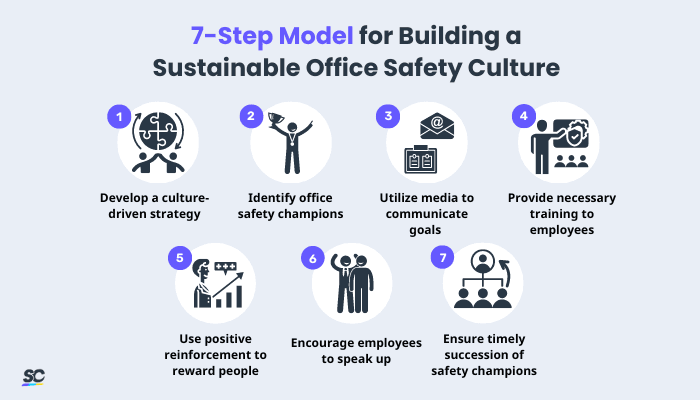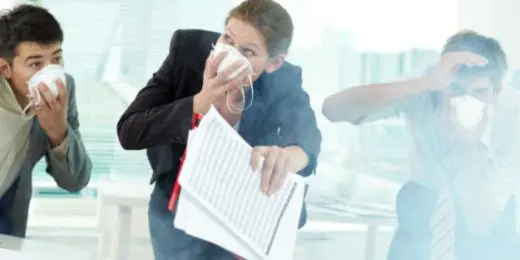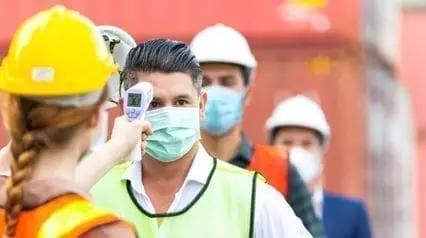What is Office Safety?
Office safety, also known as workplace safety, is the practice of ensuring a safe, working environment for employees and visitors. It is both the duty and moral responsibility of every company to promote wellness and prevent the likelihood of accidents in the workplace that may result in property damage, injuries, or loss of life.
Why is Office Safety Important?
“Around 76,000 workers nationwide receive disabling injuries every year.” – US Bureau of Labor Statistics
In a perfect world, every office worker should come back home in good health. Employers should commit to sustaining proper office safety and health protocols to ensure the long-term wellness of their employees and the company. Disregarding office safety guidelines exposes employees to increased risk of long-term injuries and diseases—factors that affect not only their livelihood but also how they live for years to come.
The Occupational Safety and Health Administration (OSHA) states that office safety is an obligation and requires employers to provide an office environment free from hazards. Management should ensure that employees are educated about the many office hazards that many workers may not be aware of, such as noise, poor ergonomics, damaged electrical wires, inoperative fire extinguishers, and lack of emergency plans.
Benefits
A safe and healthy office benefits both the company and the worker as it helps ensure the following:
- Improves productivity and product/service quality – Companies that devote resources to their employees’ safety and health can help reduce absenteeism and employee turnover, which can have a serious impact on productivity and profits.
- Protects company reputation – Companies that genuinely invest in the health and safety of their people will help employees develop a positive outlook on the company and its initiatives.
- Saves money for both employee and employer – An injured worker can easily mean hundreds of lost man-hours and quickly add up to billions in company expenses and insurance costs. With a well-implemented office safety and health policy, companies can help prevent employee injuries and fatal accidents that cause huge financial impacts not only to the company but also to the involved employees and their families.
- Promotes a culture of improvement – Office safety and health is not all about safety incidents and their related costs; a safety-conscious working environment is also an avenue for promoting a culture of improvement.
Create your own Office Safety checklist
Build from scratch or choose from our collection of free, ready-to-download, and customizable templates.
Browse Office Safety checklistsWhat Regulatory Bodies Govern Office Safety and Health?
“Employers have the responsibility to provide a safe and healthful workplace that is free from serious recognized hazards.” – OSHA 1970
International and national regulatory bodies were institutionalized to ensure that policies and legislation on office safety and health are developed and properly implemented. Together, these regulatory bodies help oversee organizations and how they respect legal labor requirements in practice and principle.
International Labor Organization (ILO)
For oversight of international labor standards, it is the International Labour Organization (ILO) that is responsible for bringing together governments, employers, and workers of its 187 Member States “to set labour standards, develop policies and devise programmes promoting decent work for all women and men.” As a specialized agency of the United Nations, its mission is to promote social justice and internationally recognized human and labor rights.
While there are internationally recognized office safety and health practices, legislation and regulations can still vary on a national level as each country has its own approach to enforcement.
Occupational Safety and Health Administration (OSHA) | USA
When President Richard Nixon enacted the Occupational Safety and Health Act (OSHAct) of 1970, OSHA was formed as the agency authorized to enforce protective workplace safety and health standards and regulate private employers in the 50 states, the District of Columbia, and other territories.
Health and Safety Executive (HSE) | UK
In the United Kingdom, the Health and Safety Executive (HSE) serves as the national regulator for workplace safety and health. They enforce local health and safety legislations, such as the Health and Safety at Work Act (HSWA) 1974 and The Reporting of Injuries, Diseases, and Dangerous Occurrences Regulations (RIDDOR) 1995.
The Commonwealth, States & Territories | Australia
Safe Work Australia, a statutory agency established in 2009, heads the development of national policies on health, safety, and compensation across Australia. The specific workplace health and safety (WHS) acts, regulations, and codes of practice per Australian state and territory can be found here.
Office Safety: A 7-Step Practical Guide
Office management should realize that office safety and health is not all about enforcing policies; rather, it is about building an effective and sustainable office safety culture. Below are 7 ways you can develop an office safety culture that’s sustainable in the long run.

1. Develop a strategy that is culture-driven rather than policy-driven.
Office workplaces that truly want to solve the root cause of unsafe conditions should realize that, more than the “do’s and don’ts” and safety signages, it is the culture they build that will help improve office safety in general. Leaders must develop a strategy that helps employees understand the true value of office safety and health in their lives and motivate them to go beyond compliance.
2. Identify (or create) office safety champions.
Identifying or developing champions can help management teams spread knowledge and enthusiasm on the floor. Through them, other employees will be better engaged in office safety and health discussions as they have people that they can easily talk to and treat as role models.
3. Utilize all media to communicate goals clearly.
Use every medium possible, including email blasts, meetings, and bulletin boards, to constantly communicate office safety and health goals. Top management must also be visible and involved in communications.
4. Provide necessary training to employees.
Training is an effective avenue to educate employees on basic safety skills, such as proper hazard identification, risk assessment, and incident reporting. It is also a means for getting genuine insights from employees and using these to further improve the training approach.
5. Use positive reinforcement to reward people.
Rewarding employees who exhibit know-how and show initiative will encourage repetition and become role models in the long run, encouraging others to do the same. This strategy ensures office incidents are reduced for the right reasons and further encourages employees to go beyond simply complying with office safety rules.
6. Encourage employees to always speak up.
Companies should not be complacent with decades-old policies that may not be as relevant today as they were before. If safety policies are ineffective, employees will simply work around them and inadvertently increase risk in the process.
7. Ensure timely succession of safety champions.
The departure of experienced leaders and safety champions is inevitable. To manage this loss, it is important to plan succession carefully because this will help fill in the skills and knowledge gap between the experienced employees and the younger ones.
Improve your EHS Management
Cultivate a safe working environment and streamline compliance with our EHS solutions.
Explore nowOffice Housekeeping
Office housekeeping is the systematic process of keeping an office environment clean and orderly. An effective office housekeeping program is an important element in office safety and health management as it fosters a cleaner and more organized workplace, which in turn helps the company gain the following benefits:.
- Helps employees find things easier;
- Notice items that are no longer useful and dispose them faster;
- Lower risk for fire due to less clutter;
- Less property damage;
- Improved utilization of space;
- Cleaner atmosphere; and
- improved morale.
Click here to download Workplace Housekeeping Checklists
Emergency Preparedness and Response in the Workplace
The actions taken in the initial minutes of an emergency are critical. A prompt warning to employees to evacuate, seek shelter, or initiate lockdown can save lives. This is why an employee trained to administer first aid or perform CPR can be life-saving. Action by employees with knowledge of building and process systems can also help control a leak and minimize damage to the facility, the environment, and the people within it.
5 Things to Remember During an Office Emergency
1. In cases of emergencies, an employer must ensure:
- provision of and access to first aid equipment and facilities; and
- that an adequate number of workers (or other people) have been trained to administer first aid.
2. First aid requirements may vary from one workplace to the next, depending on:
- the nature of the work
- the types of hazards present
- the size, location, number, and composition of people at the workplace
3. Every office should also have these emergency phone numbers handy:
- Fire and rescue
- Doctor and ambulance
- Poisons Information Centre.
4. Your office emergency action plan must also provide emergency procedures, which include:
- Proper evacuation procedures
- Notifying emergency service organizations at the earliest opportunity
- Emergency medical treatment and assistance
- Effective communication with the person coordinating the emergency response
- Testing of the emergency procedures, including the frequency of testing
- Information, training, and instruction to relevant workers about implementing the emergency procedures
5. It is also vital that all workers be familiar with emergency procedures and information for the workplace, such as:
- Who to report to in case of an emergency
- Emergency telephone numbers
- Evacuation procedures and the designated rendezvous points
- the type of fire extinguisher to use for different fires




